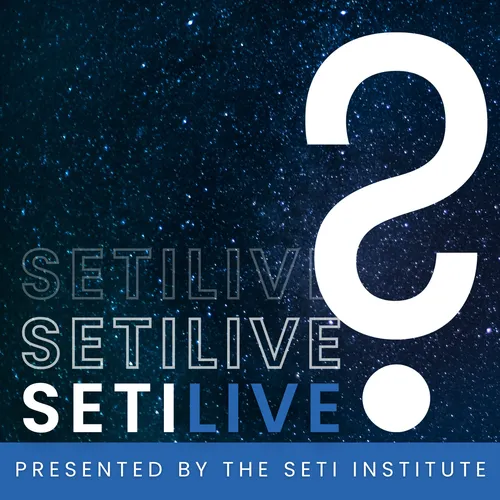
SETI Live
SETI Live is a weekly production of the SETI Institute and is recorded live on stream with viewers on YouTube, Facebook, LinkedIn, X (formerly known as Twitter), and Twitch. Guests include astronomers, planetary scientists, cosmologists, and more, working on current scientific research. Founded in 1984, the SETI Institute is a non-profit, multi-disciplinary research and education organization whose mission is to lead humanity’s quest to understand the origins and prevalence of life and intelligence in the Universe and to share that knowledge with the world.
- Update frequency
- every 7 days
- Average duration
- 34 minutes
- Episodes
- 109
- Years Active
- 2023 - 2025

SETI Artist In Residence Program: Xin Liu’s Inward Expeditions
Nimbly combining the tools of art and science, SETI Institute Artist in Residence Xin Liu expresses what it means to be human through a diverse body of work that includes frost-coated sculptures, a b…

On the Trail of Fireballs: Tracking Meteors and Finding Meteorites
Only eight times in history have scientists found an asteroid, tracked its trajectory toward Earth, and caught the resulting fireball on cameras. The latest of these eight events happened in January …

A Celestial Collaboration: Unistellar Citizen Scientists Track Comets
Throughout human history, comets have fascinated us. They have gone from signs and portents of bad things to come to well-studied and even visited "dirty snowballs". Every year, observers search the …

Under Alien Skies ft. Phil Plait, Ph.D.
Phil Plait, aka the Bad Astronomer, has been communicating and correcting space science since the turn of the century (sorry, Phil!). His first book, "Bad Astronomy", tackled numerous misconceptions …

From Earth to Mars: The Incredible Story of the Ingenuity Helicopter
With a first flight on April 19, 2021, NASA's Ingenuity helicopter broke ground on new capabilities for remote planetary missions. For nearly three years, the little drone far exceeded the originally…

The Mysterious Ocean of Saturn’s Moon, Mimas
Join us for an exciting SETI Live where we’ll explore the wonders beyond Earth. We’re excited to have Valery Lainey, a renowned researcher from the Paris Observatory in France, as our guest. Franck M…

The COSMIC Project at the Karl G. Jansky Very Large Array
In a groundbreaking cosmic quest, the SETI Institute’s Commensal Open-Source Multimode Interferometer Cluster (COSMIC) at the Karl G. Jansky Very Large Array (VLA) is expanding the search for extrate…

Ganymede's Alien Landscape: Salt, Organics, and Extraterrestrial Clues
NASA’s Juno mission has observed mineral salts and organic compounds on the surface of Jupiter’s moon Ganymede. Data for this discovery was collected by the Jovian InfraRed Auroral Mapper (JIRAM) spe…

"A City on Mars" with Kelly and Zach Weinersmith
Critically acclaimed, bestselling authors Kelly and Zach Weinersmith (Saturday Morning Breakfast Cereal) set out to write the essential guide to a glorious future of space settlements, but after year…

Unveiling the Future of Amateur Astronomy: Unistellar’s ODYSSEY Telescope
Join us for an exclusive SETI Live event, as we take a first look at the next-generation telescope from Unistellar - the ODYSSEY.
First introduced in 2017 with their eVscope, Unistellar has been a pr…

What to Expect in 2024 in Space
The new year has begun, and it's time for your favorite hosts - Franck Marchis and Beth Johnson - to run down some of the space science to look forward to in 2024. We will talk about launches, missio…

Tracking Santa - Around the World in a Night
For our last SETI Live of 2023, senior astronomer Seth Shostak and communications specialist Beth Johnson have fun chatting about the "science" behind Santa's overnight journey. How can he deliver pr…

Drifting Signals: New Boundaries for Radio Technosignatures
In a new study published in the Astronomical Journal, researchers used the known population of exoplanets to set better thresholds for planetary effects on signals from ETIs (extraterrestrial intelli…

“The Big One”: The Most Powerful Marsquake Ever Detected
On Earth, we understand how and where earthquakes happen due to the discovery of plate tectonics – the continental crust’s creation, movement, and destruction. However, when astronauts placed seismom…

Defending the Planet - DART and Future Missions
The Universe is trying to kill us. We know an asteroid wiped out the dinosaurs, which was great for the rise of mammals, but how do we prevent a similar fate for humanity? Enter the Double Asteroid R…

Women With Impact, a conversation with SETI AIR Director Bettina Forget
Look at a Moon atlas, and you’ll see a land populated with the names of philosophers, mathematicians, and astronomers. Great men like Plato, Aristarchus, Kepler, Galileo, Newton, and Planck have been…

Evidence of (16) Psyche’s Metallic Nature Found with SOFIA
Led by Anicia Arredondo, researchers used the Stratospheric Observatory for Infrared Astronomy (SOFIA) to investigate the metallic nature of the asteroid Psyche, believed to be rich in metals. SOFIA …

An Abundance of Space Rocks - The OSIRIS-REx Sample Revealed
Launched on Sept. 8, 2016, the Origins, Spectral Interpretation, Resource Identification, and Security-Regolith Explorer, or OSIRIS-REx, spacecraft traveled to a near-Earth asteroid named Bennu (form…

Volcanism on Exoplanets - New Insights from JWST and Beyond
Up until now, the quest to find evidence of active volcanism on other worlds has been limited to our own solar system. We've definitively seen volcanoes erupting on Jupiter's moon, Io; we've possibly…

Hot Spot on the Moon - Granite Batholith Found Below Surface
The Apollo missions showed scientists that the craters on the Moon were from impacts rather than volcanoes, overturning previously held hypotheses. Now, new research using data collected by China's C…